Constantia Wine Tasting and Hout Bay

Beez Neez now Chy Whella
Big Bear and Pepe Millard
Thu 2 Jan 2020 23:57
|
Constantia Wine Tasting and
Hout Bay
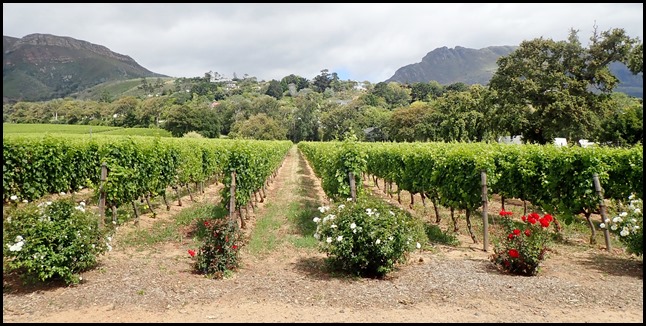 We hopped off one bus and hopped on
another to arrive at the oldest vineyard in South Africa. Before we left the bus
we had heard that it was built by slaves, is the most respected label in the
world, the vines cover 170 hectares and three quarters is for red wine, the rest
for white.
 The plaque in the
garden told us that Groot Constantia has been producing wine for 361
years.
 The gang decided it was brunch time
so we settled in Jonkershuis Eatery. Patricia smiled behind our first ‘up and
personal’ with the National Flower – the protea. Then
followed quite the saga as eight people had to choose from an extensive menu.
Thankfully, we had an incredibly patient waitress.....
   The others had pancakes, eggs Benedict and omelette
with mushrooms.
  Bear had burger
with all the trimmings and I chose what I thought was a cheese and tomato toasty with a bit of bacon on the
side....
 Getting this lot to pose.....Ostrika, Nauti Nauti, Canace and Beez Neez.
  Then looked over the pristine vines and went in search of our
tasting.
 We headed toward the beautiful building......
  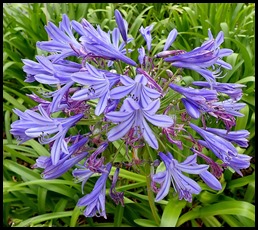 .... and took in some agapanthus on the way.
  The sundial
with neatly kept gardens and the pond
area.
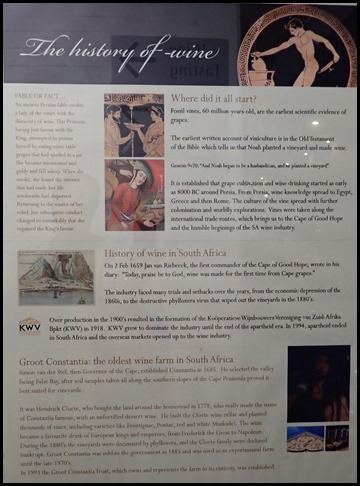 We bought the Wine and Chocolate
Tasting and glass in hand went to read the information boards. The History of
Wine reads: Fable or fact... An ancient Persian fable credits a lady of the
court with the discovery of wine. This Princess having lost favour with the
King, attempted to poison herself by eating some table grapes that had spoiled
in a jar. She became intoxicated and giddy and fell asleep. When she awoke the
stresses that made her life intolerable had dispersed. Returning to the source
of her relief, her subsequent conduct changed so remarkably that regained the
King’s favour.
Where did it all start ? Fossil
vines, 60-million-years-old, are the earliest evidence of grapes. The earliest
written account of viniculture is in the Old Testament of the Bible which tells
us that Noah planted a vineyard and made wine. Genesis chapter 9 verse 20:
“And Noah began to be a husbandman, and he planted a vineyard.” It is
established that grape cultivation and wine drinking started as early as 8000 BC
around Persia, wine knowledge spread to Egypt, Greece and then Rome.
The culture of the vine spread with further colonisation and worldly
explorations. Vines were taken along the international trade routes, which
brings us to the Cape of Good Hope and the humble beginnings of the SA wine
industry.
History of wine in South Africa:
On the 2nd of February 1659 Jan van Riebeeck, the first commander of the Cape of
Good Hope, wrote in his diary: “Today, praise be to God, wine was made for
the first time from Cape grapes.”
The industry faced many trials
and setbacks over the years, from the economic depression of the 1860s, to the
destructive phylloxera virus that wiped out the vineyards in the 1880s. Over
production in the 1900s resulted in the formation of the Kooperative Wijnbouwers
Vereiging van Zuid-Afrika Bpkt (KWV) in 1918. KWV grew to dominate the industry
until the end of the apartheid era. In 1994, apartheid ended in South Africa and
the overseas markets opened up the wine industry.
Groot Constantia: the oldest wine
farm in South Africa. Simon van der Stel. then Governor of the Cape, established
Constantia in 1685. He selected the valley facing False Bay, after soil samples
taken all along the southern slopes of the Cape Peninsula proved it best suited
for vineyards.
It was Hendrick Cloete, who
bought the land around the homestead in 1778, who really made the name of
Constantia famous, with an unfortified dessert wine. He built the Cloete wine
cellar and planted thousands of vines, including varieties like Frontignac,
Pontac, red and white Muskadel. The wine became a favourite drink of European
kings and emperors, from Frederick the Great to Napoleon. During the 1880’s the
vineyards were decimated by phylloxera, and the Cloete family were declared
bankrupt. Groot Constantia was sold to the government in 1885 and was used as an
experimental farm until the late 1970’s.
In 1993 the Groot Constantia
Trust, which owns and represents the farm in its entirety, was
established.
   Export from 1994 to 2006. Production by country and a vat branding iron from the 19th
century.
  We all sat at a table beside a farm
cart with a meeting room beyond. The
farm cart is from the late 19th century. This type of cart forms part of a
group of open carts made in many variants and called bokkies, an Afrikaans word
derived from the word buggy. Farm carts like this one, which is similar to The
Caledonian which was manufactured by Retief, De Ville & Co. from Paarl, were
built for farm use and rough travelling.
  The tasting
room and Grand Constance. Indeed when we
toured Longwood House on St Helena we would see that Napoleon had this wine
especially imported for his tipple of choice. I stayed with whites and thought
some of the chocolate a little odd, Bear enjoyed both red and white, and we came
away with our glasses wrapped up. Some of the prices (when we looked them up)
were cheaper in the supermarkets......on we went.
 Walking toward the bus stop we took in
more of the views over vineyards........
   ......and watched some ducks about their scruffing.
 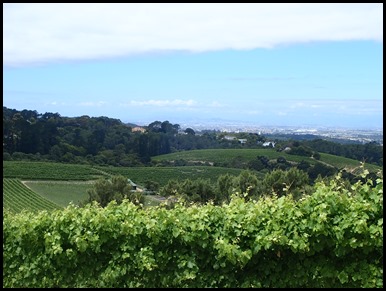 A short ride on the Hop On Hop Off saw
us at Beau Constantia.
 Our first protea
bush.
  Quite a trek on some steep paths but
beautiful scenery.
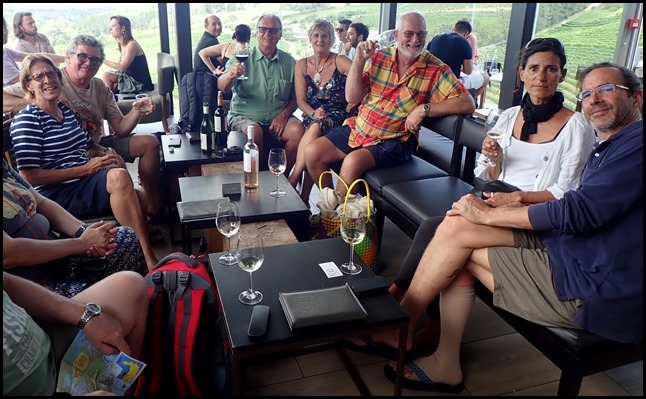 Soon the gang was
settled. I didn’t want to do a tasting so I settled with a perfectly
pleasing rose.
  Bear caused great
mirth as he leaned over the gate with ‘his
loot’.
   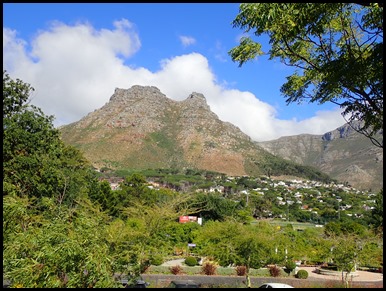  Back on the
bus, we headed to Hout Bay, a sandy, seaside
town famous for its fish and chips.
   Too early to eat, we took a seaside
bimble to take in the scenery.
 We met a couple of ladies who wanted
to pose with a crazy gang of yachties.
   At five thirty the restaurant The
Wharfside Grill, allowed us to sit in reception to await opening at six.
Time for us to take in the curios and Nelson without an eye patch........This figurehead of a
look-alike Nelson (without eye-patch) hails from Greenwich, England. Although
acquired in 1992, it was carved several decades previously, and, according to
the seller, was designed for the prow of a sailing schooner, which, due to the
advent of fuel-propelled ships, was never built. Thus its well-preserved
condition, having never been exposed to the ravages of a seafaring
life.
 The fun
menu.
 Bear and I went for prawn cocktail followed by local fish and chips –
delicious.
    Sitting out on the balcony overlooking
the mountains we watched as the
sun changed the colours and then set.
 Too late now to get a HOHO bus, it
was very amusing to watch two men (or the three
degrees – Kevin and Bear)
organise an Uber Taxi, hysterical when it turned out that they had both
ordered the same one...... Irma was bemused. Soon enough we had tumbled in to
two taxis and wended our way home.
ALL IN ALL QUITE A DAY WITH
SOME GIGGLES
A GOOD BIT OF
FUN |